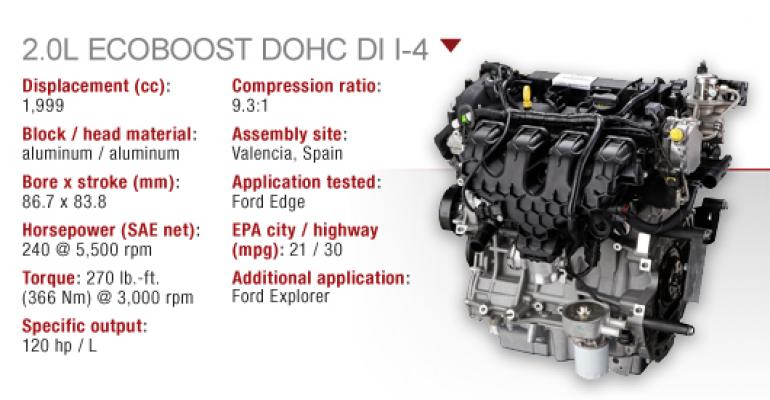Some Ward’s 10 Best Engines winners make the list by virtue of their intoxicating exhaust note, neck-snapping torque, ingenious technology or creamy smooth refinement.
Occasionally, an engine gets the nod for being the first of its kind or because it represents a bold new powertrain strategy for a particular auto maker. Past examples include the Toyota Prius when it first made the list in 2001 and Chrysler’s Pentastar V-6, which earned honors in 2011 and 2012.
Count Ford’s 2.0L EcoBoost 4-cyl. within this esteemed group. It fights well above its weight class, with 240 hp and 270 lb.-ft. (366 Nm) of torque, which is more than adequate to power the Edge, a 5-passenger midsize cross/utility vehicle, as well as the Explorer, a 7-passenger SUV.
These two high-volume vehicles are core products that serve as Ford’s standard bearers in a meat-and-potatoes segment that is critically important to any auto maker’s bottom line.
Consumers have downsized their vehicle purchases in recent years in response to volatile fuel prices, but Ford smartly dangles this stout turbocharged direct-injection I-4 as a carrot for those wanting utility, without the obligatory V-6 to motivate it.
Ten years ago, in a completely different market, a prospective buyer would have laughed at the idea of a 4-cyl. ute of this size.
But Ford now has the right idea at the right time: With the DOHC EcoBoost, the 2-ton (1.8-t) Edge is rated at 30 mpg (7.8 L/100 km) on the highway, making it the ideal powertrain for long commutes and family road trips.
Heavy-footed WardsAuto editors, logging 430 miles (692 km) in mixed driving, managed to see 24 mpg (9.8 L/100 km) during their evaluations. A lighter foot minimizes intervention by the turbocharger, which boosts fuel economy further.
With a specific output of 120 hp/L, Ford delivers the kind of engine that soon will be the norm as auto makers scramble to meet pending fuel-economy targets.
Ford has an “all-in” betting strategy with EcoBoost, which first arrived two years ago in the Taurus SHO with the direct-injection, twin-turbo 3.5L V-6 that earned a Ward’s 10 Best Engines trophy.
The same engine works magnificently now in the F-150 pickup, and some 40% of customers are clamoring for that powertrain option. By 2013, EcoBoost engines will be available in 90% of Ford vehicles.
This year, with regulations bearing down, the EcoBoost 4-cyl. wins us over with its commendable throttle response, low-friction coated piston skirts, ability to run on regular unleaded gasoline and twin independent variable camshaft timing, which helps the 2.0L to breathe easier.
“Pound for pound, it’s as solid as a 6-cyl.,” writes judge Eric Mayne on his Edge scoresheet.
Ford deserves credit for using an engine this small in vehicles so large – and doing it well.





